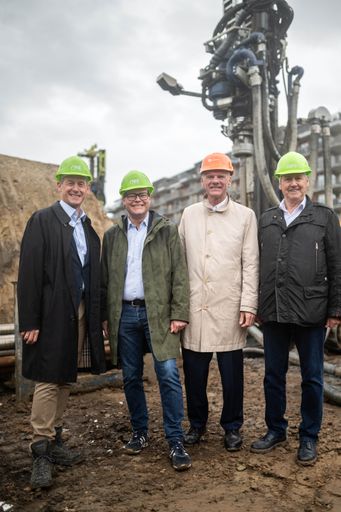With the Village in the third, the ARE Austrian Real Estate (are) is developing a sustainable new city district together with partners: around 2,000 apartments, offices, commercial space and local supply as well as childcare and educational institutions are being created around a public park. The focus of the climate -friendly energy concept of Vienna Energie and ARE is the use of locally available, renewable resources. As much energy as possible should be produced and used directly on site. An important milestone has now been reached, and Austria’s largest field of earth is being completed.
Largest earth probe in Austria
Around two years ago, the holes started for a total of 500 geothermal probes, which are an essential part of the energy concept. The last probes are currently being set before the construction work of the third construction stage starts. The geothermal probes each range 150 meters deep and enable the use of the ground to heat in winter and to temper in summer. The probes are merged through lines to the largest anergi network in Austria, which transports geothermal energy to the buildings. Specifically, this means that the geothermal energy gets into the in -house heat pumps with 5 ° C to 19 ° C via the probes, which further increase the temperature for heating. The electricity for the heat pumps comes directly from the photovoltaic systems on the roofs of the buildings. All buildings are also connected to the district heating and electricity grid in order to guarantee both the supply of supply on sun low or very cold days as well as to deliver hot water.
Overall climate -friendly concept
Spread heating systems, such as underfloor heating or component activation, are used to heat the apartments. These systems only need low flow temperatures, so that the heat pumps can be operated even more efficiently. In summer, the excess warmth is guided out of the buildings and stored in the ground by means of probes. During winter, this heat is brought back from the ground and used for the heating using a heat pump. A large part of the heating energy can be obtained from local resources. In addition, waste heat that is withdrawn from the buildings in summer is used for the production of hot water.
Quotes
“The village in the third is a window in the livable future of Vienna, because here attractive green space is combined with short paths and climate-friendly energy. What will be standard in the completion of the new city district should in future become a standard. Because Vienna’s future is full of green space, short distances, good air and renewable and affordable energy. completely climate -neutral city, which also offers a high quality of life in future generations, already more tangible “says Climatic city Jürgen Czernohorszky.
“The area sets a sign with the Village in the third: We continue to build and, together with partners, develop urgently needed living space, offices and commercial space around a two hectare park. In terms of energy supply, the village sets new standards with the largest use of geothermal energy in Austria. This gains a large part of the heating energy from local, renewable sources“, says Are managing director Gerald Beck.
“In Village in the third party, the energy future will be reality. Vienna Energie and Are show in this climate protection district how modern urban life with high comfort and gentle use of resources goes hand in hand”, “ so Michael Strebl, Chairman of the Vienna Energy Management.
“Energy from your own Grätzl – this is not only smart, but also a strong commitment to climate protection and innovation. With the largest earth probe in Austria, we show how sustainable energy supply can work in the middle of the city. I am particularly pleased that the third district is taking on a pioneering role here”says District head Erich Hohenberger.
Overall project Village in the third
The Village, consisting of 22 construction fields, is developed in the third by the Are as a neighborhood developer together with the Wohnfonds_wien and the City of Vienna. The area realizes five construction fields together with UBM Development. The new district will be built on an approximately eleven hectare area by 2027.
The central, approximately two hectares of park in the heart of the district is a relaxing retreat, but also offers sports as well as playing and has a positive effect on the entire neighborhood. In addition, all non -accessible roofs and some of the facades are greened. In addition to an almost car -free and bicycle -friendly design of the neighborhood, local suppliers, childcare, schools and offices also contribute to short distances in the city and thus an environmentally friendly handling of resources.
The project is funded by the BMLUK environmental funding.
